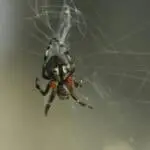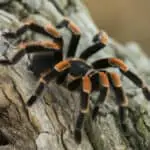Jumping spiders are fascinating creatures that have captured the attention of many people due to their unique abilities. One of the most impressive things about these arachnids is their jumping ability. But just how high can a jumping spider jump?
Jumping spiders are known for their incredible jumping prowess, which allows them to leap great distances in a single bound. They are able to jump up to 50 times their own body length, which is an impressive feat for such a small creature. But how do they do it? Understanding the mechanics behind their jumping ability can help us appreciate just how amazing these spiders really are.
Key Takeaways
- Jumping spiders can jump up to 50 times their own body length.
- They use a combination of hydraulic pressure and muscle power to propel themselves through the air.
- Jumping spiders are important predators in many ecosystems, and play a vital role in controlling insect populations.
Understanding Jumping Spiders
Jumping spiders are fascinating creatures that belong to the Salticidae family. They are known for their incredible jumping ability and their unique appearance. In this section, I will provide you with some insights into the characteristics of these spiders, including their species and family, appearance and color, and vision and eyes.
Species and Family
Jumping spiders are part of the Salticidae family, which is one of the largest spider families. There are over 5,000 species of jumping spiders, making them one of the most diverse groups of spiders in the world. Some of the most common jumping spider species include the Regal Jumping Spider, the Zebra Jumping Spider, and the Bold Jumping Spider.
Appearance and Color
Jumping spiders are small in size, with most species measuring less than 2 cm in length. They are known for their unique appearance, which includes large eyes, furry bodies, and colorful markings. The color of jumping spiders varies depending on the species, with some species being brightly colored and others being more muted in color.
Vision and Eyes
One of the most distinctive features of jumping spiders is their eyes. They have eight eyes, with the largest pair being the primary eyes. These eyes are incredibly powerful and allow jumping spiders to see in great detail. In fact, their vision is so good that they can see in color and have been known to recognize their owners.
In conclusion, jumping spiders are fascinating creatures that are known for their incredible jumping ability and unique appearance. They belong to the Salticidae family and come in a wide range of colors and sizes. Their vision is one of their most impressive attributes, with their large eyes allowing them to see in great detail.
Habitat of Jumping Spiders
Jumping spiders are found all around the world, and they live in a variety of habitats. They are commonly found in tropical forests, but they can also be found in other habitats like grasslands and deserts. In this section, I will discuss the different habitats of jumping spiders.
Tropical Forests
Jumping spiders are most commonly found in tropical forests. These forests are home to a wide variety of species, and jumping spiders are no exception. They can be found on the forest floor, in the understory, and even in the canopy. They are often found on leaves, flowers, and other vegetation, where they hunt for prey.
Grasslands and Deserts
Jumping spiders are also found in grasslands and deserts. In these habitats, they are often found on the ground, where they hunt for prey like insects and other arthropods. They are also found on rocks and other surfaces, where they can bask in the sun and regulate their body temperature.
Jumping spiders are adapted to a wide range of habitats, and they are able to thrive in many different environments. Whether they are in a tropical forest or a desert, they are always on the lookout for their next meal. With their incredible jumping abilities and keen eyesight, they are one of the most fascinating creatures in the animal kingdom.
Jumping Ability of Spiders
Jumping spiders are known for their incredible jumping ability, which allows them to leap distances far greater than their body size. In this section, we will explore the jumping ability of spiders and how they are able to accomplish such feats.
Distance and Height
Jumping spiders are able to jump distances ranging from a few centimeters to 50 times their own body length. For instance, a 2 cm long jumping spider can jump up to a distance of 1 m. In terms of height, jumping spiders can jump up to six times their own body length. This incredible jumping ability is due to the spider’s ability to store elastic energy in its legs and use it to propel itself through the air.
Role of Muscles and Legs
When a jumping spider wants to jump, it uses a sudden change in hemolymph (blood) pressure to propel itself upward. By contracting muscles that join the upper and lower plates of the cephalothorax, the jumping spider can effectively decrease the volume of blood in this region of the body. This causes an instant increase in blood flow to the spider’s legs, which allows it to jump quickly and with great accuracy.
The legs of jumping spiders are also specially adapted for jumping. They are covered in tiny hairs called setae, which allow the spider to grip onto surfaces and maintain its position during a jump. Additionally, the muscles in the legs are arranged in such a way that they can generate a large amount of force in a short amount of time, which is necessary for a successful jump.
In conclusion, the jumping ability of spiders is truly remarkable and is due to a combination of factors, including the spider’s ability to store elastic energy in its legs and the specialized muscles and hairs in its legs. By understanding the mechanics of spider jumping, we can gain a greater appreciation for these fascinating creatures.
Predation and Diet
Jumping spiders are carnivorous and are known for their exceptional hunting skills. They prey on a wide range of insects, including flies, crickets, moths, beetles, and ants. They are also known to eat other spiders, including members of their own species.
Catching Prey
Jumping spiders are unique in their hunting technique. They do not spin webs to catch their prey; instead, they actively hunt and stalk their prey. They use their excellent vision to spot their prey and then leap towards them, using their powerful legs to cover a distance up to 50 times their body length.
Their vision is so sharp that they can see objects up to 8 inches away, which is impressive given their small size. They have four pairs of eyes, with the largest pair located in the front and center of their head. These eyes have a high resolution and allow them to see in color and in three dimensions.
Dietary Variations
While jumping spiders are primarily carnivorous, they have been known to consume plant matter and nectar occasionally. This is because some species of jumping spiders have been observed feeding on nectar-producing plants.
In addition to their regular diet, jumping spiders have been known to consume more exotic prey occasionally. This can include small insects from the tropics and other spider species.
It is essential to provide live prey to feed your jumping spider. This is because they are active hunters and prefer to catch their prey themselves, rather than being fed pre-killed insects. Providing live prey also ensures that they get the necessary nutrients and exercise required for their overall health and wellbeing.
In conclusion, jumping spiders are skilled hunters that prey on a wide range of insects and other spiders. They use their excellent vision and powerful legs to catch their prey, and they prefer to hunt and catch live prey rather than being fed pre-killed insects.
Interaction with Humans
Jumping spiders are generally harmless to humans and do not pose a significant threat. However, they can bite if they feel threatened or cornered. In this section, we will discuss spider bites and how to get rid of jumping spiders.
Spider Bites
Jumping spider bites are not dangerous and are usually not painful. The venom is not toxic to humans and does not cause any significant symptoms. If you are bitten by a jumping spider, you may experience mild redness and swelling at the site of the bite. In rare cases, some people may experience an allergic reaction to the venom, which can cause more severe symptoms such as itching, hives, and difficulty breathing. If you experience any of these symptoms, seek medical attention immediately.
How to Get Rid of Jumping Spiders
Jumping spiders are beneficial to the environment as they feed on insects and other pests. However, if you have a jumping spider infestation in your home, you may want to get rid of them. Here are some ways to get rid of jumping spiders:
- Use a vacuum cleaner to remove spiders and their webs from your home.
- Seal any cracks or gaps in your home’s walls, windows, and doors to prevent spiders from entering.
- Use spider repellents such as peppermint oil, vinegar, or citrus to deter spiders from entering your home.
- Keep your home clean and clutter-free to reduce the spider’s hiding places.
In conclusion, jumping spiders are harmless to humans and play an essential role in the ecosystem. If you are bitten by a jumping spider, seek medical attention if you experience any severe symptoms. If you have a jumping spider infestation in your home, use the methods mentioned above to get rid of them.
Unique Jumping Spider Species
Jumping spiders are known for their incredible jumping abilities, but did you know that there are some unique species among them? Let’s take a closer look at some of the most interesting and unusual jumping spider species.
Phidippus Audax
Phidippus Audax, also known as the bold jumping spider, is a common species in North America. These spiders are known for their black and white markings, as well as their ability to jump up to six times their body length. They are also known to be very curious and will often approach humans.
Bagheera Kiplingi
Bagheera Kiplingi is a species of jumping spider that is unique in that it is primarily vegetarian. These spiders feed on a specialized type of plant called Beltian bodies, which are found on acacia trees. They are also known for their bright green coloration, which helps them blend in with the leaves of the trees they live on.
Phidippus Regius
Phidippus Regius, also known as the regal jumping spider, is a species that is native to the southern United States and Mexico. These spiders are known for their bright colors, which can range from metallic green to bright red. They are also capable of jumping up to six times their body length and are known to be very active hunters.
Peacock Spider
The Peacock Spider, also known as Maratus volans, is a species of jumping spider that is native to Australia. These spiders are known for their colorful and elaborate courtship displays, which involve the males raising their brightly colored abdomens and waving them in the air. They are also capable of jumping up to 50 times their body length and are known for their incredible agility.
In conclusion, jumping spiders are a fascinating group of arachnids, and these unique species are just a few examples of the incredible diversity that can be found within this group. Whether you are interested in their jumping abilities or their colorful appearances, there is no denying that jumping spiders are truly amazing creatures.
Conclusion
Jumping spiders are fascinating creatures that can jump impressive distances. According to the provided search results, a jumping spider can jump up to 50 times its own body length, which can be up to 5 meters. However, in general, jumping spiders are able to jump distances ranging from a few centimeters to thirty times their own body length.
Bold jumping spiders are known to jump distances of up to 50 times their own body length, and Regal Jumping Spiders can jump up to 6.3 inches (16cm). They use a sudden change in hemolymph pressure to propel themselves upward, and by contracting muscles that join the upper and lower plates of the cephalothorax, they can effectively decrease the volume of blood in this region of the body.
Jumping spiders can be helpful to many different environments because they prey on other insects. While they can bite people, their bites are usually not harmful and are comparable to a bee sting.
In conclusion, jumping spiders are impressive creatures that can jump great distances. While they are not harmful to humans, they play an important role in their ecosystems by preying on other insects.
Frequently Asked Questions
What is the jumping height of a jumping spider?
Jumping spiders are known for their incredible jumping ability. They can jump up to 50 times their body length, which means that if a jumping spider is 2 cm long, it can jump up to a distance of 1 m. This incredible ability is due to the jumping spider’s ability to store elastic energy in its legs and use it to propel itself through the air.
How does the jumping spider jump?
Jumping spiders have a unique way of jumping. They use their legs to push themselves off the ground and into the air. They also use their silk to anchor themselves to a surface, which helps them to jump even farther. When a jumping spider jumps, it can change direction mid-air, which makes it difficult for predators to catch them.
Which species of jumping spider can jump the highest?
There are many different species of jumping spiders, and they all have different jumping abilities. However, the Habronattus species is known to be one of the best jumpers. This species can jump up to six times its body length, which is higher than most other jumping spiders.
Can jumping spiders jump far enough to escape predators?
Jumping spiders are known for their incredible jumping ability, and they use this ability to escape predators. When a jumping spider is threatened, it can jump away quickly and change direction mid-air, which makes it difficult for predators to catch them.
Are jumping spiders the only spiders that can jump?
Jumping spiders are not the only spiders that can jump, but they are the best jumpers. Other spiders, such as wolf spiders and lynx spiders, can also jump, but they cannot jump as far or as accurately as jumping spiders.
How does the jumping ability of jumping spiders compare to other animals?
Jumping spiders are not the only animals that can jump. Fleas, grasshoppers, and kangaroos are all known for their jumping ability. However, jumping spiders are unique in their ability to change direction mid-air, which makes them one of the most agile jumpers in the animal kingdom.








